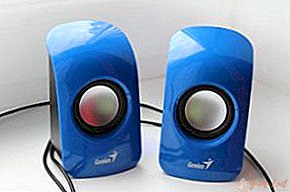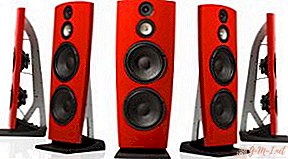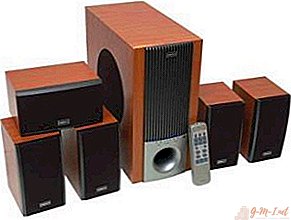The word "column" is quite ambiguous, it is used in various fields and directions. In this text, this word will be used in the meaning of a device that transfers and reproduces sound information from third-party media - a player, computer, removable disk. The size of the music column may vary depending on the destination.

What are columns
Music speakers are special devices that are installed additionally and are used to transmit sound. In all devices except a PC, they duplicate and replace standard speakers. There are no pre-installed output devices on personal computers, so they need speakers (the simplest of them are included when purchasing the device) to play information. In addition, additional music devices, such as a home theater, also need speakers. Manufacturers artificially create the need for additional peripheral audio devices, creating very weak standard speakers.

Column Classification
Columns (or column systems) can be classified according to different criteria:
- By design:
 Correct geometric shapes with decorated corners - cubes and parallelepipeds. It is believed that this form will improve the sound output.
Correct geometric shapes with decorated corners - cubes and parallelepipeds. It is believed that this form will improve the sound output.- Geometric figures without corners - trapezoids, pyramids, etc. The form has more design than technical value.
- Round or oval - it is believed that such options are better suited for reproducing sound in broadband mode.
- By the number and direction of channels:
- Single-channel - using only one output device, which plays all the channels outgoing from the host. An economical option that does not create a three-dimensional effect.
- Multichannel - systems that use multiple speakers with or without subwoofer control. Created with the aim of changing the sound quality, applying audio effects to it and creating a sense of presence.
- By frequency range:
- Monitors - the outlet openings have an average diameter, which causes all sound waves of different frequencies to overlap each other, this sometimes causes distortion.
- Tweeters are small speakers that can distribute waves of different frequencies. They are placed in different places in order to give the sound a surround effect.
- By connection type:
 Wired is the easiest way. Uses a cable to provide communication between the main unit and speakers. At the moment, this connection method is considered obsolete and inconvenient.
Wired is the easiest way. Uses a cable to provide communication between the main unit and speakers. At the moment, this connection method is considered obsolete and inconvenient.- Wireless - a way newer and more convenient, but requiring extra energy.
- By the presence of a sound amplifier:
- Passive - do not amplify, or do it very weakly. Typically, these speakers require additional amplifiers to amplify the sound.
- Active - speakers with built-in amplifiers. By themselves, they can also be divided into types.
- Configuration differences.
Due to the many devices that require additional sound distribution, as well as the variety of companies that produce them, the speakers are divided into many varieties. The list of the main types of equipment:
- Monocolumn (1.0) is not the most popular type, but the cheapest and easiest. It is just one speaker with a single-channel audio output. A cheap and optimal choice for those who do not seek to control sound effects, but simply seeks a louder sound than the standard equipment.
 Dual (2.0) - providing stereo-type playback, that is, two-channel. This type of output device requires a pair of parallel installed devices. Most of the time they reproduce the same sound, but in rare moments specially programmed for this, a certain effect can occur in only one column (the effect of the appearance of sound from the side). It is considered the best option when creating a musical background or while playing a computer game. Frequently encountered problems are a malfunction of one of the speakers, and, as a result, incomplete reproduction of the soundtrack of a soundtrack or movie picture.
Dual (2.0) - providing stereo-type playback, that is, two-channel. This type of output device requires a pair of parallel installed devices. Most of the time they reproduce the same sound, but in rare moments specially programmed for this, a certain effect can occur in only one column (the effect of the appearance of sound from the side). It is considered the best option when creating a musical background or while playing a computer game. Frequently encountered problems are a malfunction of one of the speakers, and, as a result, incomplete reproduction of the soundtrack of a soundtrack or movie picture.- The double speakers and subwoofer (2.1) are an improvement on the previous version. A subwoofer is added to the two speakers, which provides an increase in sound quality, as well as additional settings according to preferences - for example, lower bass levels or extra volume. This set expands the capabilities of the user, however, and requires him to lay out a larger amount than just two columns.
 Five speakers and a subwoofer (5.1) - configuration for rich music lovers with a refined hearing. Such a system involves the installation of three speakers on one side - the left, right, and the main - and two on the sides - side sound settings, which are also divided into the left and right channels. The subwoofer is placed approximately in the center, but closer to the main settings. This arrangement will provide even greater sound quality, as well as the presence effect and the ability to customize the acoustic effects. If necessary, this system can be equipped in 2.1 or 2.0, if any element is out of order.
Five speakers and a subwoofer (5.1) - configuration for rich music lovers with a refined hearing. Such a system involves the installation of three speakers on one side - the left, right, and the main - and two on the sides - side sound settings, which are also divided into the left and right channels. The subwoofer is placed approximately in the center, but closer to the main settings. This arrangement will provide even greater sound quality, as well as the presence effect and the ability to customize the acoustic effects. If necessary, this system can be equipped in 2.1 or 2.0, if any element is out of order.- Seven speakers with a subwoofer (7.1) - the most complex and sophisticated system of those designed for private use. Her equipment involves the presence of three speakers in front, two on the sides, the remaining two - behind the audience. It is proposed to place the subwoofer closer to the center and front of the structure. All these improvements will allow a person to feel at a recording studio or at a presentation of a computer game.
Connection and setup
Connecting speakers to a computer in most cases does not cause problems for users, but occasionally problems occur. The sequence of steps for connecting speakers to a PC:
IMPORTANT. Before starting work, you must completely turn off the computer or laptop, and then turn off the power. Adding new devices while the PC is running can cause problems.
- The easiest way is to connect systems like 1.0 and 2.0. You need to take the wire coming from the speaker (s), ending with the head of the plug. It should be inserted into one of the holes in the PC sound card designed for sound output. Such holes are marked in green. The speakers must be turned on using the button on the case.
 To use systems 2.1 and above, it is necessary to connect the speakers to the inlet openings of the subwoofer, not the computer. The inputs of the subwoofer should be marked with, for example, "left" (left) and "right" (right). The plug belonging to the subwoofer should be inserted into the corresponding green hole on the computer or laptop. As for more complex systems, they require a suitable sound card on the main device, since they use several pairs of wires. On a laptop or computer, there must be several inputs of different colors for complex audio systems.
To use systems 2.1 and above, it is necessary to connect the speakers to the inlet openings of the subwoofer, not the computer. The inputs of the subwoofer should be marked with, for example, "left" (left) and "right" (right). The plug belonging to the subwoofer should be inserted into the corresponding green hole on the computer or laptop. As for more complex systems, they require a suitable sound card on the main device, since they use several pairs of wires. On a laptop or computer, there must be several inputs of different colors for complex audio systems.

 Correct geometric shapes with decorated corners - cubes and parallelepipeds. It is believed that this form will improve the sound output.
Correct geometric shapes with decorated corners - cubes and parallelepipeds. It is believed that this form will improve the sound output. Wired is the easiest way. Uses a cable to provide communication between the main unit and speakers. At the moment, this connection method is considered obsolete and inconvenient.
Wired is the easiest way. Uses a cable to provide communication between the main unit and speakers. At the moment, this connection method is considered obsolete and inconvenient. Dual (2.0) - providing stereo-type playback, that is, two-channel. This type of output device requires a pair of parallel installed devices. Most of the time they reproduce the same sound, but in rare moments specially programmed for this, a certain effect can occur in only one column (the effect of the appearance of sound from the side). It is considered the best option when creating a musical background or while playing a computer game. Frequently encountered problems are a malfunction of one of the speakers, and, as a result, incomplete reproduction of the soundtrack of a soundtrack or movie picture.
Dual (2.0) - providing stereo-type playback, that is, two-channel. This type of output device requires a pair of parallel installed devices. Most of the time they reproduce the same sound, but in rare moments specially programmed for this, a certain effect can occur in only one column (the effect of the appearance of sound from the side). It is considered the best option when creating a musical background or while playing a computer game. Frequently encountered problems are a malfunction of one of the speakers, and, as a result, incomplete reproduction of the soundtrack of a soundtrack or movie picture. Five speakers and a subwoofer (5.1) - configuration for rich music lovers with a refined hearing. Such a system involves the installation of three speakers on one side - the left, right, and the main - and two on the sides - side sound settings, which are also divided into the left and right channels. The subwoofer is placed approximately in the center, but closer to the main settings. This arrangement will provide even greater sound quality, as well as the presence effect and the ability to customize the acoustic effects. If necessary, this system can be equipped in 2.1 or 2.0, if any element is out of order.
Five speakers and a subwoofer (5.1) - configuration for rich music lovers with a refined hearing. Such a system involves the installation of three speakers on one side - the left, right, and the main - and two on the sides - side sound settings, which are also divided into the left and right channels. The subwoofer is placed approximately in the center, but closer to the main settings. This arrangement will provide even greater sound quality, as well as the presence effect and the ability to customize the acoustic effects. If necessary, this system can be equipped in 2.1 or 2.0, if any element is out of order. To use systems 2.1 and above, it is necessary to connect the speakers to the inlet openings of the subwoofer, not the computer. The inputs of the subwoofer should be marked with, for example, "left" (left) and "right" (right). The plug belonging to the subwoofer should be inserted into the corresponding green hole on the computer or laptop. As for more complex systems, they require a suitable sound card on the main device, since they use several pairs of wires. On a laptop or computer, there must be several inputs of different colors for complex audio systems.
To use systems 2.1 and above, it is necessary to connect the speakers to the inlet openings of the subwoofer, not the computer. The inputs of the subwoofer should be marked with, for example, "left" (left) and "right" (right). The plug belonging to the subwoofer should be inserted into the corresponding green hole on the computer or laptop. As for more complex systems, they require a suitable sound card on the main device, since they use several pairs of wires. On a laptop or computer, there must be several inputs of different colors for complex audio systems.
Leave Your Comment